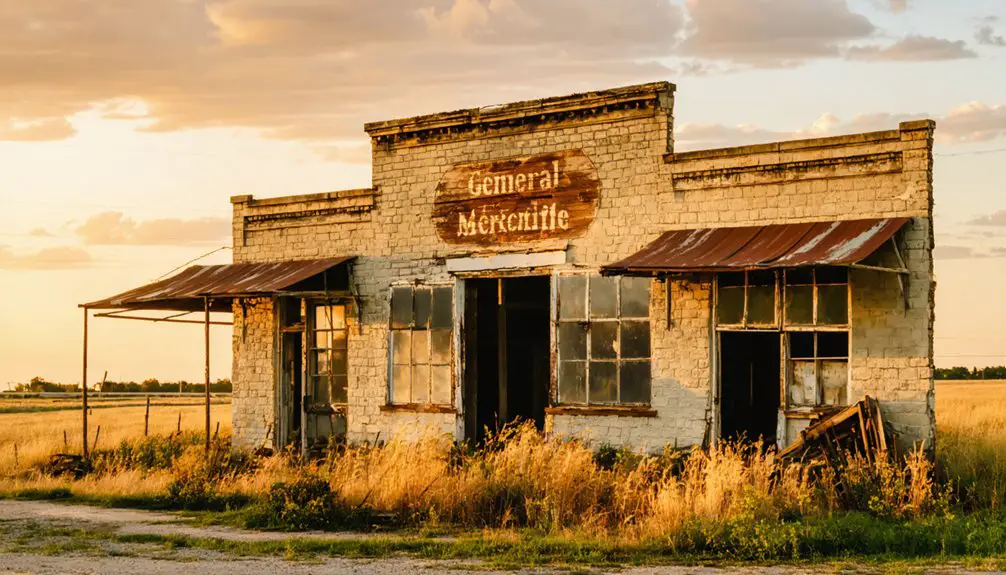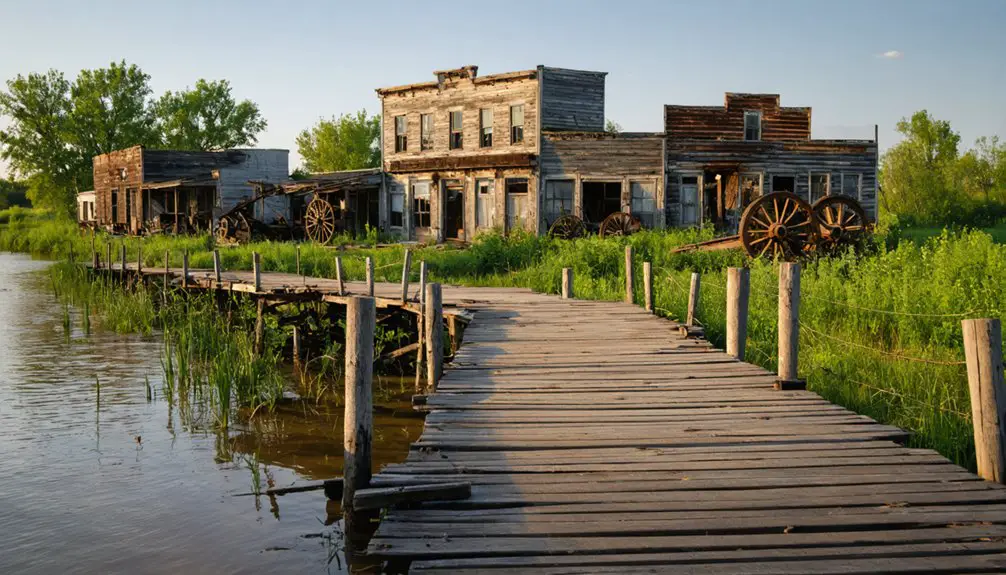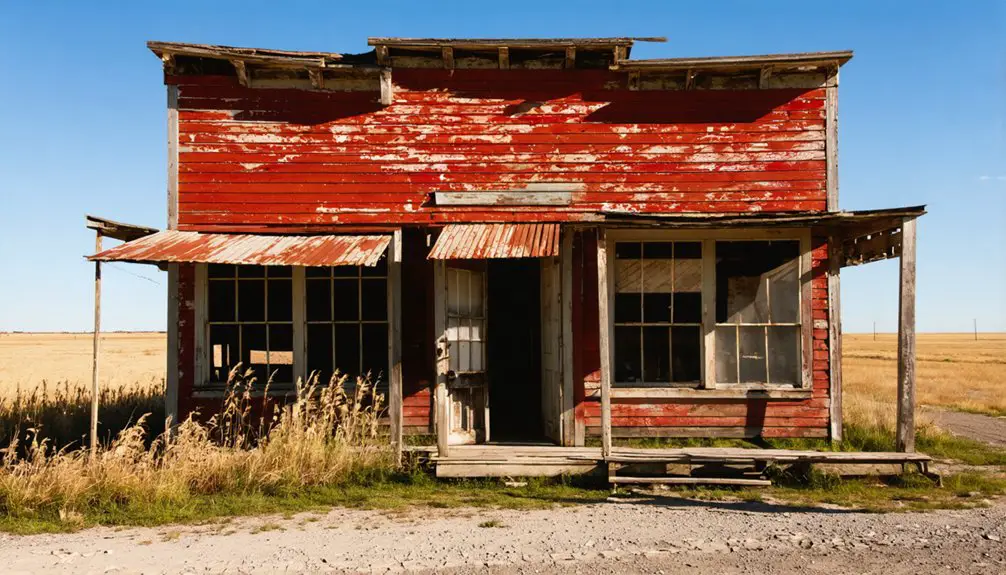You’ll find the ghost town of Doniphan, Kansas along the Missouri River, where it once thrived as a bustling port in the 1850s. Native American tribes first settled this land before European traders and settlers established a vibrant river commerce hub. Despite its promising start, devastating floods in 1881 and 1891 destroyed critical railroad infrastructure, while competing towns with better rail connections drew away business. The town’s rich history of cultural exchange and resilience lies waiting in its quiet remains.
Key Takeaways
- Doniphan transformed from a thriving Missouri River port town in the 1850s to an abandoned settlement after devastating floods and railway bypasses.
- The catastrophic flood of 1881 destroyed critical railroad infrastructure, leading rail companies to abandon routes through Doniphan permanently.
- Economic decline accelerated when the Government Land Office relocated to Kickapoo in 1858, diminishing the town’s regional importance.
- The final blow came with the flood of 1891, which washed away remaining railroad tracks and severely damaged the town’s infrastructure.
- Natural disasters, poor transportation access, and economic isolation led businesses to close and residents to relocate by the late 19th century.
Native American Heritage and First Settlements
Before becoming a ghost town, Doniphan’s lands were home to diverse Native American peoples whose presence stretched back to Paleolithic times.
You’ll find traces of nomadic hunters and gatherers who first roamed these lands, followed by Neolithic Indians who settled here 700-800 years ago to cultivate corn, squash, and beans.
The Kansa Indians made their mark by the early 1600s, establishing the Grand Village des Canzes near the Missouri River after migrating from St. Louis.
By the 1830s, new tribes including the Kickapoo, Ioway, Sac, and Fox created early settlements in the area.
You can trace their legacy through the trading posts, missions, and burial mounds that dotted the landscape, including the Presbyterian Mission near Highland that served as an essential educational center for Native Americans.
In 1852, Josephus Utt’s trading post marked one of the earliest white settlements in the region and helped establish connections between Native Americans and incoming settlers.
The first recorded European contact with the area came when French explorer Bourgmont visited in 1724, documenting his encounters with local tribes.
Birth of a River Town: Early Foundations
While steamboats navigated the Missouri River in late 1854, a group of enterprising settlers gathered in St. Joseph, Missouri, to form the Doniphan Town Company.
Led by T.H. Christopher as president, these community leaders strategically chose a location with superior drainage atop river bluffs and a rock-bound landing perfect for steamboat traffic.
You’ll find the town’s early foundations were meticulously planned. Similar to the Mount Vernon Town Company formed in 1856, early development focused on acquiring strategic land claims.
Surveyor James F. Forman laid out the streets and lots in spring 1855, receiving town lots as payment. He quickly built the first structure – the Forman Brothers Store – which doubled as the post office.
James Forman surveyed and plotted Doniphan in 1855, earning town lots before establishing the first store and post office.
The town company’s trustees facilitated rapid development by promoting land sales and establishing essential infrastructure.
With abundant woods nearby and a primitive ferry service by 1856, Doniphan was poised for growth as a promising river town.
The arrival of the government land office in 1857 brought the town’s first wave of prosperity, attracting new businesses and settlers to the area.
Trading Post to Economic Hub

After Josephus Utt established his trading post in 1852 near the Missouri River banks, Doniphan’s evolution into an economic hub began taking shape.
You’d have found the trading post serving as the heart of early governance and commerce, with James F. Forman’s store housing the first post office by 1855.
The economic shift gained momentum as steamboat traffic brought settlers and goods, while local industries emerged.
You could’ve witnessed Forman’s sawmills and flour mills diversifying the economy beyond simple trading.
Loess soil deposits reaching depths of over 100 feet along river bluffs provided rich farmland that supported the area’s agricultural growth.
By the 1870s, you’d have seen the Atchison and Nebraska Railroad reshape commerce, as rail lines connected Doniphan to broader markets.
The St. Joseph & Western Railway’s arrival further accelerated this change from river-based trade to rail-centered commerce, briefly revitalizing the town’s prospects.
The Brenner Vineyard building, constructed in 1869, enhanced local industry with its impressive 90,000-gallon wine storage capacity.
Political Tensions and Social Climate
During the 1850s and 1860s, you’d have found Doniphan at the heart of intense political conflict, as Free State and Pro-slavery factions battled for control of the region.
Political rivalries reached a boiling point when the Government Land Office was moved to Kickapoo in 1854, diminishing Doniphan’s influence. You’d have witnessed groups like the Free State “Crusaders” forming to resist pro-slavery “Tigers,” while the secretive Danites threatened violence to further their cause. The Squatters Association formed to protect settler land claims and maintain order amid the chaos.
Tension exploded in Doniphan after the Land Office moved to Kickapoo, sparking violent clashes between Free Staters and pro-slavery forces.
The removal of the land office in 1858 marked a significant turning point in the town’s decline, as businesses began relocating to more prosperous areas.
The social unrest manifested in frequent criminal activity, with bodies found in the river and businesses requiring nightly guards.
The robbery of A.B. Symns’ store and Missouri Dooley’s tragic shooting by a guard exemplified the dangerous atmosphere. Even local newspapers like the Doniphan Democrat reflected the deep political divisions that would ultimately shape the town’s destiny.
Natural Disasters and Transportation Changes
You’ll find that Doniphan’s fate was largely sealed by the Missouri River’s relentless flooding and erosion, which repeatedly damaged buildings and infrastructure along the town’s vulnerable riverbank location.
When the railroad era arrived, Doniphan’s late adoption of rail infrastructure and inability to compete with better-positioned towns further accelerated its decline. Like many river towns, it relied heavily on steamboat traffic for economic survival.
The challenging terrain and limited road connections to surrounding communities compounded these problems, making it increasingly difficult for the town to maintain its economic viability.
River Flooding Impact
Throughout its history, the Missouri River’s unpredictable flooding patterns played a decisive role in Doniphan’s eventual demise as a thriving settlement. You’d find that without modern flood mitigation systems, the town’s position along the muddy river left it vulnerable to nature’s whims.
The river dynamics wreaked havoc on Doniphan’s essential infrastructure, particularly damaging the riverboat landings that served as economic lifelines. The Kansa Indians settlement had endured similar challenges in the region since the 1600s.
The impact extended beyond immediate water damage. You’ll see how the 1881 flood proved especially devastating, disrupting railroad access and severing critical transportation routes.
The repeated flooding eroded riverbanks, destroyed businesses, and gradually forced both goods and people to seek alternative routes. What began as minor seasonal overflows eventually transformed into a relentless force that accelerated Doniphan’s decline and isolation.
Railroad Reroute Aftermath
The arrival of the Atchison & Nebraska Railroad in January 1871 sparked initial optimism for Doniphan’s growth, but nature had other plans.
When the devastating flood of 1881 washed away the railroad infrastructure, you’d have witnessed the beginning of Doniphan’s railroad decline. Rail companies abandoned their routes through the town, seeking more reliable paths less prone to natural disasters.
This rerouting led to severe economic isolation as Doniphan lost its position as an essential transportation hub.
You’d have seen businesses that once thrived on steamboat and rail traffic struggle to survive, while regular mail and freight services ceased.
As the St. Joseph & Western Railroad bypassed the town to serve coal regions, residents and industries relocated to better-connected areas, leaving Doniphan to fade into a ghost town.
Challenging Road Connections
While the Missouri River’s devastating flood of June 1891 carved a new southern channel through the region, it also washed away thousands of yards of essential railroad tracks near Doniphan, permanently altering the town’s transportation landscape.
You’ll find that road maintenance became a constant struggle, as the town’s dirt paths were particularly vulnerable to the region’s challenging weather conditions.
Seasonal variations, from winter snow to spring mud, regularly disrupted travel and commerce. The soil’s instability near the riverbank made connectivity issues even worse, demanding resources the small town couldn’t sustain.
Without reliable roads to compensate for the lost rail routes, Doniphan’s isolation intensified. The lack of dependable transportation alternatives left the town struggling to maintain crucial economic connections, ultimately contributing to its decline as a viable trading hub.
From Bustling Port to Abandoned Settlement

During its peak in the 1850s, Doniphan flourished as an essential Missouri River port town, bustling with steamboat commerce and frontier trade.
You’d have found a vibrant community centered around Forman’s store, which doubled as the post office and social hub, while cultural influences from Native American traders and European settlers shaped the town’s unique character.
But economic shifts hit hard as railroads bypassed the settlement and the Missouri River’s unpredictable nature created navigational challenges.
You can trace Doniphan’s decline through the late 19th century, as businesses shuttered and residents sought opportunities elsewhere.
Legacy Along the Missouri River
Along the banks of the Missouri River, Doniphan’s legacy interweaves the stories of multiple cultures, from the Kanza Indians‘ Grand Village des Canzes to the European settlers who later claimed the land.
Beside the mighty Missouri, Native and European histories flow together, shaping the cultural landscape of early Doniphan.
The river shaped both indigenous cultural practices and early American commerce, with burial mounds dotting the bluffs and steamboats later churning the waters below.
You’ll find echoes of this heritage in the region’s artifacts and infrastructure, from prehistoric relics to the remains of what was once the finest rock-bound landing above St. Louis.
While the river brought prosperity through steamboat trade and fertile bottomlands, it also hastened Doniphan’s decline.
The 1891 flood carved a new channel, undermining the town’s foundation and marking nature’s lasting power over human ambition.
Frequently Asked Questions
Are There Any Remaining Original Structures Still Standing in Doniphan Today?
While most structures are decaying, you’ll find St. John’s Catholic Church still stands restored, plus the historic preservation district includes Brenner Vineyards’ architectural significance with its winery, barn, smokehouse and other original buildings.
What Happened to the Residents When Doniphan Became a Ghost Town?
You’ll find that residents’ fate involved moving to nearby towns with better economic prospects. During ghost town shifts, most people relocated where railroads and industries offered more sustainable opportunities.
Can Visitors Legally Explore the Doniphan Ghost Town Site?
Like entering an uncharted frontier, you’ll need to secure landowner permission first – there aren’t established visitor regulations for ghost town exploration, and the site’s likely on private property.
Were Any Valuable Artifacts Recovered From Doniphan’s Abandoned Buildings?
You’ll find artifacts of significant historical value were recovered, including catlinite pipes, pottery vessels, iron objects, brass items, and rare record stones – though most buildings were stripped before abandonment.
What Is the Current Ownership Status of the Doniphan Townsite?
Keeping your finger on the pulse of current ownership isn’t clear-cut – you’ll need to check Doniphan County records, as the townsite’s fragmented parcels likely belong to private landowners or county jurisdiction.
References
- https://www.legendsofamerica.com/doniphan-kansas/
- https://lostkansas.ccrsdigitalprojects.com/sites/lostkansas/files/private_static/2022-12/LT_DP_DoniphanAndGrandVillageDesCanzes_Martello.pdf
- https://www.ksgenweb.org/archives/doniphan/history/1905/1-1a.html
- https://www.youtube.com/watch?v=8MTb39F-4tc
- https://dpcountyks.com/doniphan-county-history/
- https://legendsofkansas.com/doniphan-county-kansas/
- http://freepages.rootsweb.com/~pyle/genealogy/Plat1882/CutlerDoniphan.htm
- https://alincolnguide.com/doniphan-info/
- http://www.kansasheritage.org/werner/mosquito.html
- https://www.kancoll.org/books/cutler/doniphan/doniphan-co-p3.html



